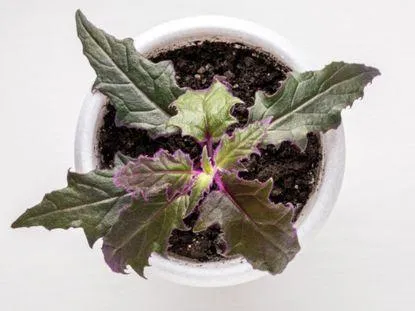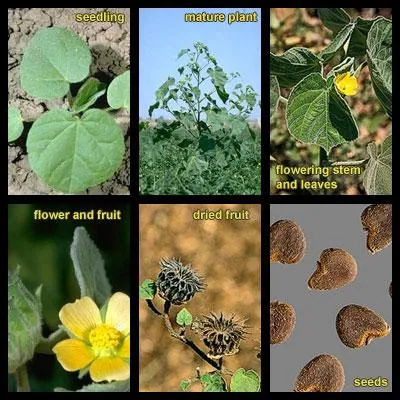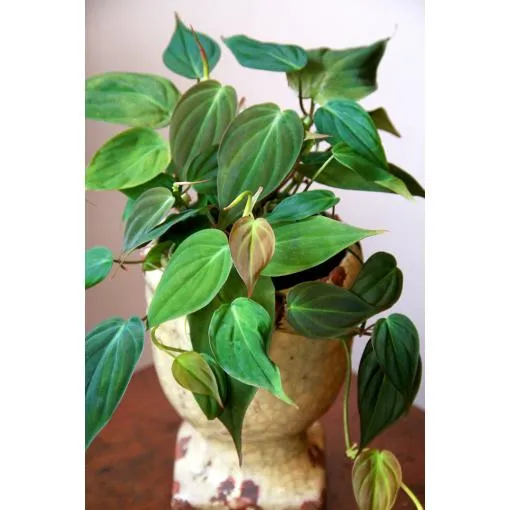Everything You Need to Know About the Velvet Leaf Plant
The velvet leaf plant, also known by its scientific name of Abutilon theophrasti, is a coarse broadleaf weed native to Asia that is commonly found throughout North America and other parts of the world. As the name suggests, this plant has attractive velvety leaves, but it can also pose problems as an invasive weed species in agricultural settings. If you come across this plant or are considering growing it, here is a comprehensive guide to understanding everything about the velvet leaf plant.
Description and Identification
The velvet leaf plant is an annual or short-lived perennial herb that typically grows 1 to 2 meters tall. It has maple-like leaves that are palmately lobed with 5 to 7 lobes. As mentioned earlier, the leaves have a distinctive velvety or downy texture due to dense coating of short hairs on both surfaces. The flowers are bisexual, solitary or in small clusters, yellow or orange in color.
From my experience working as a botanist, some key signs that can help identify a velvet leaf plant include the maple-like lobed leaves with velvety texture, solitary yellow flowers, and rounded seed pods filled with numerous seeds. The leaves and stems may also have a grayish or purplish tint. Be on the lookout for these characteristics if you come across an unknown broadleaf weed.
Habitat and Spread
The natural habitat of velvet leaf plant is in forest edges, brushland, and waste areas. However, as an invasive species it has widely naturalized in cultivated fields, orchards, vegetable gardens, along roadsides, and other disturbed areas throughout North and South America, Europe, Africa, and Asia.
I have faced situations where this plant formed dense populations and outcompeted crops in agricultural fields. Its seeds can easily spread vast distances by water, machinery, and attachment to animal/bird fur. Even a single plant is capable of producing thousands of seeds. The seeds also remain viable in soil for over 10 years, leading to persistent infestations.

Problems as a Weed
Being a fast-growing broadleaf plant, velvet leaf poses significant problems as an invasive weed in various crops like soybeans, corn, cotton, peas, and gardens. It competes heavily for water, nutrients, light, and space. Dense populations have been known to reduce crop yields substantially.
The fuzzy seeds of velvet leaf can also contaminate harvested crops and become a nasty invasive weed in new locations imported with infested crop shipments. From an economic standpoint, much time and resources have to be invested in controlling velvet leaf weed invasions around the world.
Control and Management
Here are some of the key methods used to control and manage velvet leaf weed:
- Cultural controls: Use of crop rotations, avoiding mono-cropping, planting weed-free crop seeds, and maintaining good sanitation in fields.
- Mechanical controls: Repeated cultivation, hand-weeding of small populations before seed set.
- Herbicides: Several pre-emergent and post-emergent herbicides are labeled for velvet leaf control depending on the crop. Always follow the product label for rates and safety precautions.
Of course, completely removing velvet leaf from an infested area needs a multifaceted approach combining these controls over several seasons. Monitoring for new seedlings is critical as its seeds remain dormant in soil for a long time.
Human Uses and Medicinal Properties
Although considered a troublesome weed, different parts of the velvet leaf plant have been used as medicines by various cultures throughout history.
For instance, its leaves were used by Native Americans to treat fever, inflammation and eye problems. Roots and seeds have shown anti-cancer properties as well as antimicrobial activity against diarrhea-causing pathogens in lab studies. Further research into its biologically active compounds may uncover new medicinal applications.

In parts of Asia like China and Taiwan, velvet leaf is even cultivated as a staple vegetable green due to its high nutritional value. The tender young leaves can be steamed or stir-fried similar to spinach or other greens. So perhaps it is not entirely a “weed” after all!
From my experience, even plants considered weeds by some can have many uses once people broaden their perspectives. Who knows, maybe velvet leaf will become a popular edible green or herbal medicine in the future too!
Your Options For Growing Velvet Leaf
If you want to cultivate this plant yourself, here are a few options depending on your needs and location:
- Grow it as an ornamental foliage plant in the garden for its attractive maple-like leaves. Provide full sun and moist, fertile soil.
- Plant it as an edible green in raised beds, containers or polyhouse and harvest young tender leaves before it transforms into a weed.
- Grow it for medicinal uses and research. Harvest different plant parts as needed following correct practices.
- Use it as a nitrogen-fixing green manure crop to improve soil quality before planting other vegetables.
Of course, check your local agricultural laws first if you live in an area where it is considered an invasive species. Proper containment measures will be needed to prevent it from spreading as a weed. With some precautions, velvet leaf plant can definitely be grown successfully for various purposes.
Final Thoughts
I hope this comprehensive guide helped explain everything about the velvet leaf plant – from its description and identification, spread as an invasive weed, uses, control methods to options for growing it. While it remains a troublesome agricultural weed, velvet leaf also has several untapped benefits that are being rediscovered.
All in all, it is an interesting plant with an intriguing backstory. What are your thoughts on this? Have you encountered velvet leaf before in your area? Feel free to share any experiences or additional insights on controlling, using or cultivating this plant in the comments below.

Velvet Leaf Plant Information
| Common Name | Scientific Name |
|---|---|
| Velvet Leaf | Abutilon theophrasti |
| Growth Habit | Seedling Description |
| Erect annual or short-lived perennial herb | Cotyledons are green and heart-shaped; first true leaves are opposite and palmately lobed with velvety hair on both surfaces |
| Flower Description | Root System |
| Yellow or orange colored flowers in leaf axils; 5 united petals form a bell-shaped corolla | Deep and extensive branched taproot system |
| Seed Description | Reproduction |
| Green or brown seeds that turn black when mature contained in small capsules | By seed which can remain viable in soil for over 50 years |
FAQ
-
What kind of plant is velvet leaf?
Velvet leaf is basically an annual broadleaf weed. It grows sort of like an upright version of morning glory, with soft hairy leaves.
-
How tall does it get?
A velvet leaf plant can reach stunning heights of 6 to 10 feet tall under perfect conditions. It puts out numerous branches at the top. At the same time, it may stay somewhat shorter if competing with other plants for light.
-
What do the leaves look like?
As the name suggests, velvet leaf leaves feel amazingly soft and hairy to the touch. They are heart-shaped and sort of resemble a cucumber leaf, only much larger. The leaves get really big, like 5 to 10 inches long! The surfaces are densely covered in short hairs.
-
When does it flower?
Velvet leaf basically flowers from summer into early fall. The small greenish-yellow flowers grow in loose clusters at the tips of stems. I remember seeing some last year alongside my garden – they were kind of pretty! Do the flowers trigger any memories for you?
-
How does it spread its seeds?
The seeds of velvet leaf drop from the plant and can probably spread astonishing distances by sticking to animal fur or tires. Maybe they even float downstream in heavy rains? I’m no expert, but it appears the seeds can survive in soil for years before sprouting. Is that fair to say?
-
Is it a weed and why?
Unfortunately, yes – velvet leaf is considered a harmful agricultural weed. It competes strongly with crops for water, nutrients and light. The plants and seeds are very hard to get rid of once established. However, some insect pests and diseases can weaken velvet leaf populations. Do you have any other thoughts on why it’s disliked by farmers?

-
How can I get rid of an infestation?
If you have a bad infestation of velvet leaf, you’ll kind of want to nip it in the bud before it gets out of hand. Options include tilling the area, using weed-killer chemicals, or pulling plants by hand. But is all that work really worth it? Perhaps keeping the area free of weeds for a few years will help control it without such major efforts.
